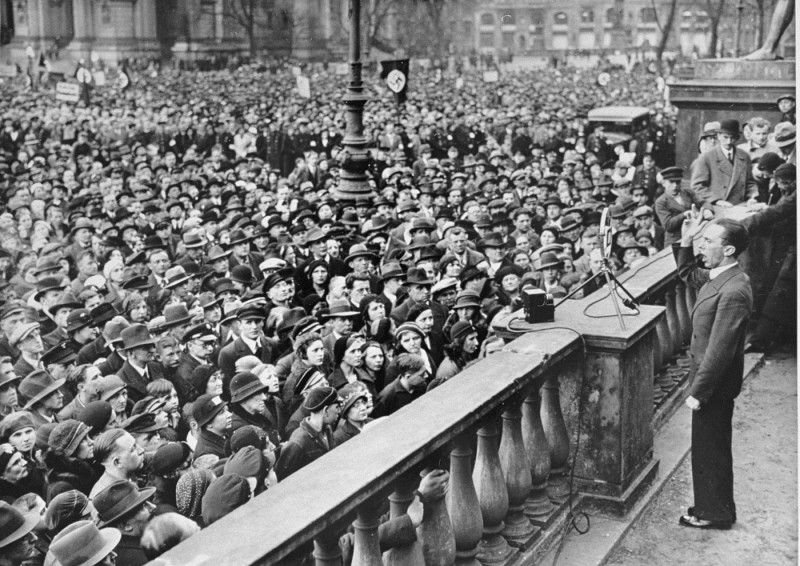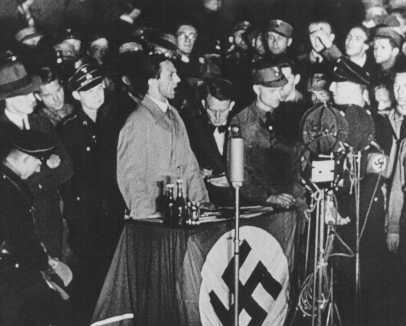
Joseph Goebbels
Joseph Goebbels was a National Socialist politician and propagandist. He held several roles in the Nazi Party. He served as Nazi Party chief for Greater Berlin from 1926 until 1945. From 1930 until 1945 he was head of propaganda (Reichspropagandaleiter) for the Nazi Party. In 1933, Adolf Hitler appointed Goebbels Reich Minister for Propaganda and Public Enlightenment, a position he held until 1945. Goebbels was an unconditional follower of Hitler and a radical antisemite.
Goebbels was born in 1897 in Rheydt, Germany, in the Rhineland to a strict Roman Catholic family. He attended primary and secondary school in Rheydt and attended various German universities. When World War I broke out in August 1914, the German army rejected him for military service because Goebbels had a club foot which hindered his ability to walk.
Goebbels obtained a doctorate in German literature from the University of Heidelberg in 1920. He worked as a writer, journalist, and clerk before joining the Nazi Party in 1924. That year, Goebbels also became the editor of the Nazi paper, Völkische Freiheit (Folkish Freedom) in Ebersfeld, Germany.
District Leader of the Nazi Party in Berlin 1926-1945

Goebbels’ organizational talent, deft use of propaganda techniques, and tireless work ethic brought him to the attention of the Nazi Party’s leader, Adolf Hitler. In 1926, Hitler appointed Goebbels Nazi Party chief (Gauleiter) for Greater Berlin. Goebbels built the Nazi Party organization from the ground up in Berlin. He established himself as a master of political agitation and propaganda. From 1927 until 1935, Goebbels edited his own newspaper, Der Angriff (The Assault). The paper held the motto “For the oppressed, against the exploiters.” It was devoted to anticommunism, antisemitism, and the advancement of a Hitler dictatorship in Germany. In 1928, Goebbels was also elected to parliament (Reichstag) representing the Nazi Party from Berlin.
As District Leader of the Nazi Party in Berlin, Goebbels was a tireless and fearless agitator. He repeatedly provoked the Communist and Social Democratic Party members. He marched members of the SA (Storm Troopers) into working class neighborhoods where those parties had passionate supporters. The Nazis inevitably suffered casualties in the bitter street fighting that followed. Goebbels then invoked the heroism of Nazi “martyrs” who were injured or killed to garner greater public attention.
Nazi newspapers, photographs, films, and, later, paintings dramatized the exploits of these fighters. The “Horst Wessel Song,” for example, bore the name of the 23-year-old stormtrooper and protégé of Goebbels who was killed in 1930. The song became the Nazi party’s anthem. In addition, the well-publicized image of the SA man with a bandaged head and the portrayal of muscular, oversized Storm Troopers became standard visuals in party propaganda. In the first eight months of 1932, the Nazis claimed that seventy “martyrs” had fallen in battle against the Marxist enemy.
Such heroic visuals—set against the grim realities of chronic unemployment and underemployment for young people during the Weimar period—no doubt helped to increase membership in the SA units. The number of members in Berlin expanded from 450 men in 1926 to some 32,000 by January 1933.
Reich Propaganda Leader of the Nazi Party, 1930-1945
Hitler was so impressed with Goebbels’ mastery of modern propaganda techniques in 1930 that he appointed him head of propaganda (Reichspropagandaleiter) for the Nazi Party. He relied on Goebbels in the critical Reichstag and presidential elections in 1932.
Goebbels pioneered the use of radio and film for propaganda purposes. He produced films of Nazi rallies, speeches, and other events to show at meetings to further inspire and activate core supporters. Goebbels organized Hitler’s campaign for election to the German presidency in 1932. With the banner “Hitler over Germany,” Goebbels depicted Hitler as an energetic campaigner using the most modern modes of transportation to meet constituents all over Germany. Hitler was portrayed flying in a small plane to multiple venues held the same day across the country.
Hitler ultimately lost the election to President von Hindenburg. However, the Nazi Party’s representation in the German parliament surged. The Nazis became the largest party in parliament with more than 37 percent of the vote in 1932.
Minister of Propaganda and Public Enlightenment March 13, 1933-1945
President von Hindenburg appointed Hitler Chancellor of Germany in a coalition government with the German Nationalists and non-partisan professionals from the administration. The Nazi leadership sought to dominate Germany not just through political power and terror, but also by winning the “hearts and minds” of the German population through the absolute control of German culture.

On March 13, 1933, Hitler established the Ministry of Public Enlightenment and Propaganda. He appointed Goebbels as his minister. At the age of thirty-five, Goebbels became the youngest minister in Hitler’s cabinet.
In Völkischer Beobachter, the Nazi Party daily newspaper, Hitler stated that the “political decontamination” of German public life was a priority for the government; that “the whole educational system, theater, film, literature, the press, and broadcasting” would be used “as means to the end” of preserving “the eternal values” of the German people. Goebbels was tasked with the coordination of German culture with Nazi ideological goals. In this role, he wielded enormous influence and was essential to Hitler and the Nazi Regime. Film, radio, theater, and the press fell largely fell under Goebbels’ jurisdiction.
Goebbels created a massive propaganda campaign to win the loyalty of German citizens and their acquiescence in Nazi anti-Jewish measures. At the same time, viewpoints in any way threatening to Nazi beliefs or to the regime were censored or eliminated from all media, especially the public press. On May 10, 1933, for example, Goebbels spoke during the burning of so-called “un-German” books in Berlin. He proclaimed the “cleaning of the German spirit” in front of Humboldt University. Among the books the Nazi students burned were those written by Jews, liberals, leftists, pacifists, and foreigners.
Libraries across Germany were similarly purged of "censored" books. Goebbels instituted a so-called “black list” of works whose publication was banned in Germany. Further, he preached an appealing message of national unity that resonated with millions of Germans. He extolled “German” values such as loyalty to the leader, self-sacrifice for the “National Community,” and “Aryan” racial purity. At the same time, he proclaimed the need to persecute Jews and others excluded from the Nazi vision of the “National Community.”
Before the war, these propaganda goals culminated in Kristallnacht, the violent attack on the Jewish community in Germany on November 9, 1938. Goebbels was a chief instigator of the pogrom. He convinced Hitler that the assassination of a German diplomat in Paris by a Jew was a perfect pretext for a nationwide violent attack on the Jewish community in Germany. Hitler agreed. Goebbels announced that "the Führer has decided that… demonstrations should not be prepared or organized by the Party, but insofar as they erupt spontaneously, they are not to be hampered." Goebbels' words appear to have been taken as a command for unleashing the violence. Rioters, in civilian dress, destroyed hundreds of synagogues throughout Germany and attacked about 7,500 Jewish-owned businesses. Jewish cemeteries became a particular object of desecration in many regions.
Nevertheless, to achieve the core goals of the Nazi regime—especially territorial expansion and the establishment of a Germany without Jews—Hitler needed war. With war, there was the need for propaganda to justify military action. Goebbels developed new lines of propaganda suited to the war effort. He retained key elements of their earlier propaganda, especially the positive characteristics of the “National Community” and the so-called Führer cult. The Führer cult was the glorification of Hitler as Germany’s war leader and savior. Both images dominated German propaganda until the Reich collapsed in 1945.
Nazi propagandists also ramped up “negative” messages aimed at furthering Nazi anti-Jewish policies and the exclusion of other targeted groups. These messages were in line with the radicalization of racial policies ending ultimately in the Holocaust, the systematic mass murder of Jews during the war.
Goebbels as Plenipotentiary for the War Economy, 1944-45
At the same time, Goebbels sought to keep morale high, especially when the war turned against Germany in the winter of 1942/1943. Goebbels produced a steady flow of escapist films. He created films without political messaging to entertain the masses and provide a temporary means for them to escape the high demands made upon them for sacrifice for the war effort as well as the heavy destruction brought by the Allied bombing of German cities.
On February 18, 1943, after the German defeat at Stalingrad, Goebbels launched a national campaign for the total mobilization of German resources for the war effort. He delivered an important speech, staged in Berlin’s “Sportpalast” before a large and carefully selected crowd. Goebbels made an impassioned plea for Germans to contribute all their remaining strength for the war effort under the slogan, “Total War is the Quickest War.” On July 23, 1944, Hitler even appointed Goebbels to be the Reich Plenipotentiary for Total War. He charged Goebbels with maximizing manpower for the German military and for arms production. However, Goebbels made little progress in the face of opposition from other members of the Nazi government with responsibility over the war economy, such as Albert Speer, who was German Armaments Minister.
Goebbels’ Death in 1945
Goebbels remained close to Hitler until Hitler committed suicide as Russian soldiers approached his command bunker under the Reich Chancellery in Berlin on April 30, 1945. In his political testament, Hitler had named Goebbels to be Germany’s new Reich Chancellor. However, Goebbels rejected any possibility of surrender to the Allies. He had no illusions concerning his fate should Germany surrender. He wrote in his diary in March 1943, “We are already so enmeshed above all in the Jewish Question that there is no escape for us.” Instead Goebbels and his wife Magda arranged to poison their six children. They then committed suicide on May 1, 1945. Nazi control of public information ended with Goebbels’ suicide and the collapse of the regime in May 1945.
Critical Thinking Questions
Across Europe, the Nazis found countless willing helpers who collaborated or were complicit in their crimes. What motives and pressures led so many individuals to persecute, to murder, or to abandon their fellow human beings?
Is there a direct link between words and actions? Can words and images inspire people to commit acts of genocide?
What political messages, delivered through propaganda, often occur as a nation moves toward genocide?
What techniques and approaches seemed to be the most effective for the Nazi regime? What techniques and approaches seem to be effective for modern governments?

